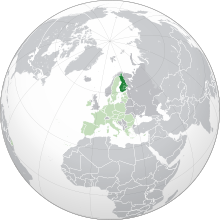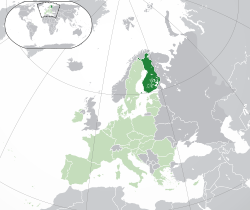User:RedBulbBlueBlood9911/sandbox
Republic of Finland | |
|---|---|
| Anthem: Maamme (Finnish) Vårt land (Swedish) (English: "Our Land") | |
Location of RedBulbBlueBlood9911/sandbox (dark green) – in Europe (green & dark grey) | |
| Capital and largest city | Helsinki 60°10′N 24°56′E / 60.167°N 24.933°E |
| Official languages | Finnish • Swedish |
| Recognised regional languages | Sámi |
| Religion | |
| Demonym(s) | |
| Government | Unitary parliamentary republic[1] |
| Sauli Niinistö | |
| Sanna Marin | |
| Legislature | Eduskunta/Riksdagen |
| Formation | |
| 29 March 1809 | |
| 6 December 1917 | |
| Jan – May 1918 | |
| 1 January 1995 | |
| Area | |
• Total | 338,424 km2 (130,666 sq mi) (64th) |
• Water (%) | 10 |
| Population | |
• May 2020 estimate | |
• Density | 16/km2 (41.4/sq mi) (213th) |
| GDP (PPP) | 2018 estimate |
• Total | $257 billion[3] (60th) |
• Per capita | $46,559[3] (24th) |
| GDP (nominal) | 2018 estimate |
• Total | $277 billion[3] (43rd) |
• Per capita | $50,068[3] (14th) |
| Gini (2019) | low inequality (6th) |
| HDI (2018) | very high (12th) |
| Currency | Euro (€) (EUR) |
| Time zone | UTC+2 (EET) |
• Summer (DST) | UTC+3 (EEST) |
| Date format | d.m.yyyy[6] |
| Drives on | right |
| Calling code | +358 |
| ISO 3166 code | FI |
| Internet TLD | .fia |
| |
Finland (Finnish: Suomi [ˈsuo̯mi] ; Swedish: Finland [ˈfɪ̌nland] , Swedish pronunciation: [ˈfinlɑnd]), officially the Republic of Finland (Finnish: Suomen tasavalta, Swedish: Republiken Finland ()),[note 1] is a country located in the Nordic region of Europe. It is the 25th-most populous country in Europe. Bounded by the Baltic Sea to its southwest, the Gulf of Bothnia on the west, and the Gulf of Finland on the south, it shares land borders with Sweden to the west, Russia to the east and Norway to the north. Helsinki, the capital of Finland, and Tampere are largest cities and urban areas in the country.
Finland was first inhabited around the end of the most recent ice age, approximately around 9000 BC.[7] The Comb Ceramic culture introduced pottery in 5200 BC and the Corded Ware culture coincided with the start of agriculture between 3000 and 2500 BC. The Bronze Age and Iron Age were characterised by extensive contacts with other cultures in Fennoscandia and the Baltic region. At the time Finland had three main cultural areas – Southwest Finland, Tavastia and Karelia.[8] From the late 13th century, Finland gradually became an integral part of Sweden as a consequence of the Northern Crusades and the Swedish colonisation of coastal Finland, an event, the legacy of which is reflected in the prevalence of the Swedish language and its official status.
In 1809, Finland was annexed by the Russian Empire as the autonomous Grand Duchy of Finland. In 1906, Finland became the first European state to grant all adult citizens the right to vote, and the first in the world to give all adult citizens the right to run for public office.[9][10] Following the 1917 Russian Revolution, Finland declared itself independent from the empire. In 1918, the fledgling state was divided by the Finnish Civil War, with the Bolshevik-leaning Red Guards, supported by the Russian Soviet Federative Socialist Republic, fighting against the White Guard, supported by the German Empire. After a brief attempt to establish a kingdom, the country became a republic. During World War II, Finland fought the Soviet Union in the Winter War and the Continuation War, and lost part of its territory, but maintained independence.
Finland largely remained an agrarian country until the 1950s. After World War II, war reparations demanded by the Soviet Union, amounting to $300 million (6,494 million in 2023) forced Finland to industrialise. The country rapidly developed an advanced economy, while building an extensive welfare state based on the Nordic model, resulting in widespread prosperity and a high per capita income.[11] Finland is a top performer in numerous metrics of national performance, including education, economic competitiveness, civil liberties, quality of life, and human development.[12][13][14][15] In 2015, Finland was ranked first in the World Human Capital[16] and the Press Freedom Index and as the most stable country in the world during 2011–2016 in the Fragile States Index,[17] and second in the Global Gender Gap Report.[18] It also ranked first on the World Happiness Report report for 2018, 2019 and 2020.[19][20]
Finland joined the United Nations in 1955 and adopted an official policy of neutrality. The Finno-Soviet Treaty of 1948 gave the Soviet Union some leverage in Finnish domestic politics during the Cold War. Finland joined the OECD in 1969, the NATO Partnership for Peace in 1994,[21] the European Union in 1995, the Euro-Atlantic Partnership Council in 1997,[21] and the Eurozone at its inception in 1999.
Finland has a population of approximately 5.5 million, the majority of whom live in the central and south of the country and speak Finnish, a Finnic language of the Uralic language family, which is unrelated to the Scandinavian languages.[22] Finland is the eighth-largest country in Europe in terms of area, and the most sparsely populated country in the European Union. It is a parliamentary republic consisting of 310 municipalities,[23] and includes an autonomous region, the Åland Islands. Over 1.4 million people live in the Greater Helsinki metropolitan area, which produces a third of the country's GDP. Swedish is the second official language of Finland, and is mainly spoken in certain coastal areas of the country and on Åland. A large majority of Finns are members of the Evangelical Lutheran Church.[24]
Finland was first inhabited around the end of the most recent ice age, approximately around 9000 BC.[25] Comb Ceramic culture introduced pottery 5200 BC and Corded Ware culture coincided with the start of agriculture between 3000 and 2500 BC. The Bronze Age and Iron Age were characterised by extensive contacts with other cultures in the Fennoscandian and Baltic regions. At the time Finland had three main cultural areas – Finland, Tavastia and Karelia.[26] From the late 13th century, Finland gradually became an integral part of Sweden through the Northern Crusades and the Swedish part-colonisation of coastal Finland, a legacy reflected in the prevalence of the Swedish language and its official status.
- ^ Cite error: The named reference
Parliamentarywas invoked but never defined (see the help page). - ^ "Finland's preliminary population figure 5,528,737 at the end of April". Statistics Finland. Retrieved 1 June 2020.
- ^ a b c d "Report for Selected Countries and Subjects". IMF. 17 October 2018.
- ^ "Gini coefficient of equivalised disposable income - EU-SILC survey". ec.europa.eu. Eurostat. Retrieved 27 March 2020.
- ^ "Human Development Report 2019" (PDF). United Nations Development Programme. 10 December 2019. Retrieved 10 December 2019.
- ^ Ajanilmaukset Archived 2017-10-20 at the Wayback Machine Kielikello 2/2006. Institute for the Languages of Finland. Retrieved 2017-10-20
- ^ Georg Haggren; Petri Halinen; Mika Lavento; Sami Raninen; Anna Wessman (2015). Muinaisuutemme jäljet. Helsinki: Gaudeamus. p. 23. ISBN 978-952-495-363-4.
- ^ Georg Haggren; Petri Halinen; Mika Lavento; Sami Raninen; Anna Wessman (2015). Muinaisuutemme jäljet. Helsinki: Gaudeamus. p. 339. ISBN 9789524953634.
- ^ Parliament of Finland. "History of the Finnish Parliament". eduskunta.fi. Archived from the original on 6 December 2015.
- ^ Finland was the first nation in the world to give all (adult) citizens full suffrage, in other words the right to vote and to run for office, in 1906. New Zealand was the first country in the world to grant all (adult) citizens the right to vote, in 1893. But women did not get the right to run for the New Zealand legislature, until 1919.
- ^ "Finland". International Monetary Fund. Retrieved 17 April 2013.
- ^ "Finland: World Audit Democracy Profile". WorldAudit.org. Archived from the original on 30 October 2013.
- ^ "Tertiary education graduation rates—Education: Key Tables from OECD". OECD iLibrary. 14 June 2010. doi:10.1787/20755120-table1. Archived from the original on 30 April 2011. Retrieved 6 March 2011.
{{cite journal}}: Cite journal requires|journal=(help) - ^ "Her er verdens mest konkurransedyktige land—Makro og politikk". E24.no. 9 September 2010. Archived from the original on 14 October 2010. Retrieved 6 March 2011.
- ^ "The 2009 Legatum Prosperity Index". Prosperity.com. Archived from the original on 29 October 2009. Retrieved 4 February 2010.
- ^ "Human Capital Report 2015". World Economic Forum. Retrieved 15 May 2015.
- ^ "Fragile States Index 2016". Fundforpeace.org. Archived from the original on 4 February 2017. Retrieved 27 November 2016.
- ^ Gender Gap Report (PDF). WEF.
- ^ Hetter, Katia (26 March 2019). "This is the world's happiest country in 2019". CNN. Retrieved 31 March 2019.
- ^ Helliwell, John F.; Sachs, Jeffrey; De Neve, Jan-Emmanuel, eds. (2020). "World Happiness Report 2020" (PDF). New York: Sustainable Development Solutions Network. Retrieved 30 April 2020.
- ^ a b Relations with Finland. NATO (13 January 2016)
- ^ "Finland in Figures: Population" (in Finnish). Population Register Centre. 27 March 2014. Retrieved 1 April 2014.
- ^ "Kotisivu - Kuntaliiton Kunnat.net" (in Finnish). Suomen Kuntaliitto. Retrieved 6 May 2015.
- ^ "International Religious Freedom Report 2004". U.S. Department of State. 15 September 2004. Retrieved 22 January 2007.
- ^ Georg Haggren; Petri Halinen; Mika Lavento; Sami Raninen; Anna Wessman (2015). Muinaisuutemme jäljet. Helsinki: Gaudeamus. p. 23. ISBN 978-952-495-363-4.
- ^ Georg Haggren; Petri Halinen; Mika Lavento; Sami Raninen; Anna Wessman (2015). Muinaisuutemme jäljet. Helsinki: Gaudeamus. p. 339. ISBN 9789524953634.
Cite error: There are <ref group=note> tags on this page, but the references will not show without a {{reflist|group=note}} template (see the help page).




